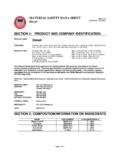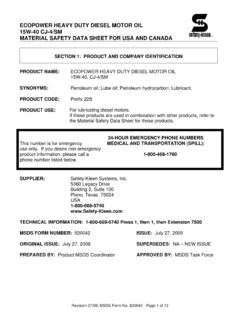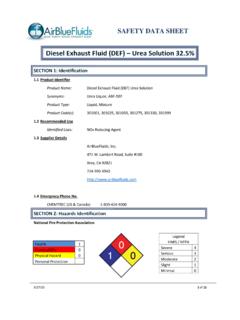Transcription of SAFETY DATA SHEET - Hall Fuels
1 Product Name: ESSO diesel . Revision Date: 18 Dec2007. Page 1 of 10. _____. SAFETY data SHEET . SECTION 1 PRODUCT AND COMPANY IDENTIFICATION. As of the revision date above, this (M)SDS meets the regulations in the United Kingdom & Ireland. PRODUCT. Product Name: ESSO diesel . Product Description: Hydrocarbons and Additives Product Code: 708110-60. Intended Use: diesel engine fuel COMPANY IDENTIFICATION. Supplier: Esso Petroleum Company, Limited ExxonMobil House Ermyn Way KT22 8UX Leatherhead, Surrey United Kingdom 24 Hour Environmental / Health Emergency 01372 222 000 (UK) / +44 1372 222 000 (Ireland). Telephone e-mail SECTION 2 HAZARDS IDENTIFICATION. This material is dangerous according to regulatory guidelines (see (M)SDS Section 15).
2 CLASSIFICATION: | Carc. Cat. 3; R40 | Xn; R65 | R66 | N; R51/53 |. PHYSICAL / CHEMICAL HAZARDS. Material can release vapours that readily form flammable mixtures. Vapour accumulation could flash and/or explode if ignited. Material can accumulate static charges which may cause an incendiary electrical discharge. HEALTH HAZARDS. Limited evidence of a carcinogenic effect. Harmful: may cause lung damage if swallowed. Repeated exposure may cause skin dryness or cracking. Under conditions of poor personal hygiene and prolonged repeated contact, some polycyclic aromatic compounds (PACs) have been suspected as a cause of skin cancer in humans. May be irritating to the eyes, nose, throat, and lungs. May cause central nervous system depression.
3 High-pressure injection under skin may cause serious damage. ENVIRONMENTAL HAZARDS. Toxic to aquatic organisms, may cause long-term adverse effects in the aquatic environment. Note: This material should not be used for any other purpose than the intended use in Section 1 without expert advice. Health studies have shown that chemical exposure may cause potential human health risks which may vary from person to person. SECTION 3 COMPOSITION / INFORMATION ON INGREDIENTS. This material is regulated as a preparation. Product Name: ESSO diesel . Revision Date: 18 Dec2007. Page 2 of 10. _____. Reportable Hazardous Substance(s) or Complex Substance(s). Name CAS# EINECS / Symbols/Risk ELINCS Concentration Phrases *. Fuels , diesel , no.
4 2 68476-34-6 270-676-1 > 94% Xn;Carc. Cat. 3;R40, Xn;R65, R66, N;R51/53. * All concentrations are percent by weight unless ingredient is a gas. Gas concentrations are in percent by volume. Note: Composition may contain up to performance additives and / or dyes. FAME (fatty acid methyl ester) may be present up to 5% - the maximum permitted by European Standard EN 590. SECTION 4 FIRST AID MEASURES. INHALATION. Remove from further exposure. For those providing assistance, avoid exposure to yourself or others. Use adequate respiratory protection. If respiratory irritation, dizziness, nausea, or unconsciousness occurs, seek immediate medical assistance. If breathing has stopped, assist ventilation with a mechanical device or use mouth-to-mouth resuscitation.
5 SKIN CONTACT. Remove contaminated clothing. Dry wipe exposed skin and cleanse with waterless hand cleaner and follow by washing thoroughly with soap and water. For those providing assistance, avoid further skin contact to yourself or others. Wear impervious gloves. Launder contaminated clothing separately before reuse. Discard contaminated articles that cannot be laundered. If product is injected into or under the skin, or into any part of the body, regardless of the appearance of the wound or its size, the individual should be evaluated immediately by a physician as a surgical emergency. Even though initial symptoms from high pressure injection may be minimal or absent, early surgical treatment within the first few hours may significantly reduce the ultimate extent of injury.
6 EYE CONTACT. Flush thoroughly with water. If irritation occurs, get medical assistance. INGESTION. Seek immediate medical attention. Do not induce vomiting. NOTE TO PHYSICIAN. If ingested, material may be aspirated into the lungs and cause chemical pneumonitis. Treat appropriately. PRE-EXISTING MEDICAL CONDITIONS WHICH MAY BE AGGRAVATED BY EXPOSURE. Hydrocarbon Solvents/Petroleum Hydrocarbons- Skin contact may aggravate an existing dermatitis. SECTION 5 FIRE FIGHTING MEASURES. EXTINGUISHING MEDIA. Appropriate Extinguishing Media: Use water fog, foam, dry chemical or carbon dioxide (CO2) to extinguish flames. Inappropriate Extinguishing Media: Straight streams of water Product Name: ESSO diesel . Revision Date: 18 Dec2007. Page 3 of 10.
7 _____. FIRE FIGHTING. Fire Fighting Instructions: Evacuate area. Prevent run-off from fire control or dilution from entering streams, sewers or drinking water supply. Fire-fighters should use standard protective equipment and in enclosed spaces, self-contained breathing apparatus (SCBA). Use water spray to cool fire exposed surfaces and to protect personnel. Hazardous Combustion Products: Aldehydes, Sulphur Oxides, Smoke, Fume, Incomplete combustion products, Oxides of carbon FLAMMABILITY PROPERTIES. Flash Point [Method]: >56C (133F) [ ASTM D-93]. Flammable Limits (Approximate volume % in air): LEL: UEL: Autoignition Temperature: >250 C (482 F). SECTION 6 ACCIDENTAL RELEASE MEASURES. NOTIFICATION PROCEDURES. In the event of a spill or accidental release, notify relevant authorities in accordance with all applicable regulations.
8 PROTECTIVE MEASURES. Avoid contact with spilled material. Warn or evacuate occupants in surrounding and downwind areas if required, due to toxicity or flammability of the material. See Section 5 for fire fighting information. See the Hazard Identification Section for Significant Hazards. See Section 4 for First Aid Advice. See Section 8 for Personal Protective Equipment. SPILL MANAGEMENT. Land Spill: Eliminate all ignition sources (no smoking, flares, sparks or flames in immediate area). Stop leak if you can do so without risk. All equipment used when handling the product must be grounded. Do not touch or walk through spilled material. Prevent entry into waterways, sewer, basements or confined areas. A vapour- suppressing foam may be used to reduce vapour.
9 Use clean non-sparking tools to collect absorbed material. Absorb or cover with dry earth, sand or other non-combustible material and transfer to containers. Large Spills: Water spray may reduce vapour, but may not prevent ignition in enclosed spaces. Water Spill: Stop leak if you can do so without risk. Eliminate sources of ignition. If the Flash Point exceeds the Ambient Temperature by 10 deg C or more, use containment booms and remove from the surface by skimming or with suitable absorbents when conditions permit. If the Flash Point does not exceed the Ambient Air Temperature by at least 10C, use booms as a barrier to protect shorelines and allow material to evaporate. Seek the advice of a specialist before using dispersants.
10 Water spill and land spill recommendations are based on the most likely spill scenario for this material;. however, geographic conditions, wind, temperature, (and in the case of a water spill) wave and current direction and speed may greatly influence the appropriate action to be taken. For this reason, local experts should be consulted. Note: Local regulations may prescribe or limit action to be taken. ENVIRONMENTAL PRECAUTIONS. Large Spills: Dyke far ahead of liquid spill for later recovery and disposal. Prevent entry into waterways, sewers, basements or confined areas. SECTION 7 HANDLING AND STORAGE. Product Name: ESSO diesel . Revision Date: 18 Dec2007. Page 4 of 10. _____. HANDLING. Avoid all personal contact. Use proper bonding and/or earthing procedures.







